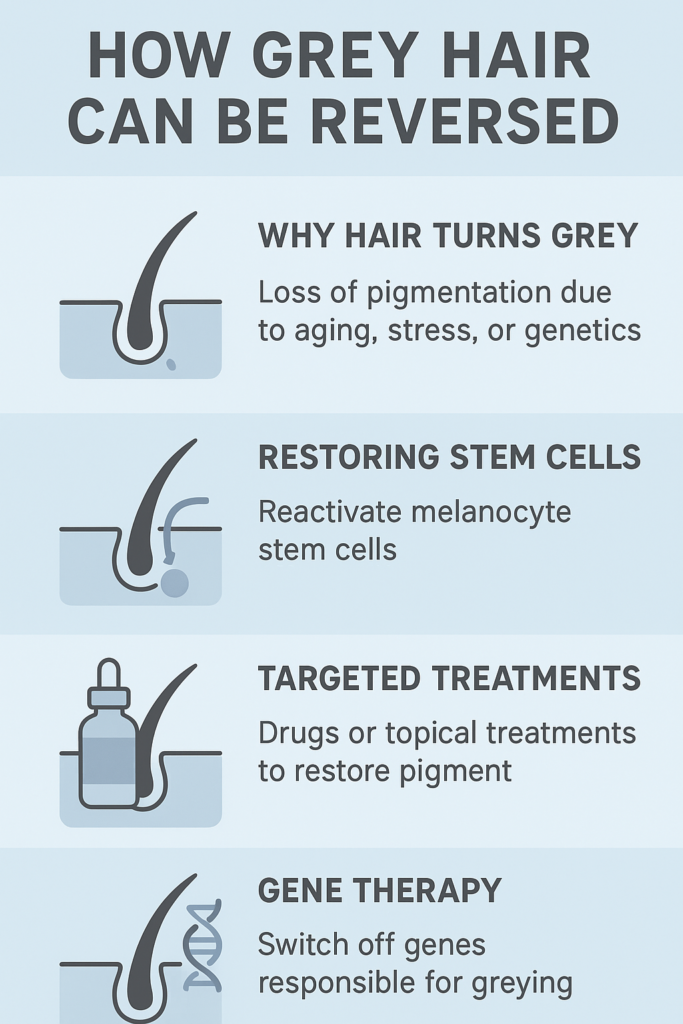Grey hair has long been seen as one of the most visible signs of aging. For centuries, people have reached for dyes and treatments to hide those silver strands. But what if grey hair didn’t have to be permanent? Recent scientific studies suggest that in some cases, grey hair could actually be reversed. This discovery is giving new hope to millions who want to hold on to their natural hair color for a little longer.
Why Does Hair Turn Grey?
To understand how reversal might work, it helps to know why hair turns grey in the first place. Our hair color comes from a pigment called melanin, which is produced by special cells called melanocytes. As we age, these cells become less active and eventually stop making pigment.
Other factors also play a role. Stress, genetics, and even lifestyle choices can speed up the greying process. Over time, the hair follicle can lose its ability to produce melanin altogether, which is why many believe greying is permanent. But scientists are now challenging that assumption.
The Breakthrough Discovery
In 2021, researchers at Columbia University made a surprising observation. By studying individual strands of hair, they noticed that some grey hairs actually regained their original color. This repigmentation was linked to changes in stress levels. When stress went down, color sometimes came back.
This finding shocked many in the scientific community. It showed that greying could be more flexible than we thought. Not every grey hair is “dead.” Some still have the potential to return to its natural shade, depending on what happens inside the body.
Below is the link to the research of the university of Columbia on grey hair
How Could Grey Hair Be Reversed?
Scientists are now exploring several possible ways to reverse grey hair:
- Restoring melanocyte stem cells: These cells act like a backup system for hair color. If scientists can “reawaken” them, hair might start producing pigment again.
- Targeted treatments: Future drugs or topical creams might help follicles regain their pigment-making ability.
- Gene therapy: Since genetics play a big role in greying, scientists are studying ways to switch certain genes back on.
- Lifestyle factors: Stress management, healthy eating, and good sleep may also slow or even partially reverse greying.
While these ideas are still in early stages, they point to a future where reversing grey hair is possible.

Challenges Ahead
Even though the discovery is exciting, it’s not a magic cure yet. If a hair follicle has lost all its pigment cells, it may not be possible to bring color back. That means some grey hair could remain permanent.
Another challenge is time. Developing safe and effective treatments takes years of research and testing. Scientists must ensure that any new therapies work well without harmful side effects. For now, the only reliable option remains hair dye.
Remedies for grey hair
Putting together the medical insights and new research, here are possible ways grey hair might be reversed:
Fixing Nutritional Deficiencies
If you have low levels of vitamin B-12, iron, copper, or folate, restoring those can sometimes help. But only if a doctor confirms the deficiency.
Addressing Health Conditions
Treating underlying thyroid issues, or managing conditions like vitiligo or alopecia areata, might help maintain or restore pigment.
Lowering Stress & Improving Lifestyle
Because stress may interrupt melanin production, reducing it (through relaxation, exercise, good sleep) might help. Also, protecting hair from damage (sun, chemicals) and avoiding smoking help slow greying.
Scientific Treatments on the Horizon
- Restoring melanocyte stem cells: Research aims to revive dormant pigment-producing cells.
- Gene therapy: Targeting genes that control pigment production could potentially reverse greying.
- Topical or drug treatments: Scientists are investigating compounds that might stimulate melanin production.
Together, these approaches might someday bring reliable ways to reverse or slow greying.
What This Means for the Future
Imagine a world where people could keep their natural hair color for decades longer. The cosmetic industry would change overnight. People might delay or even skip dyeing altogether. At the same time, society’s view of aging could shift. If visible signs like grey hair become reversible, people may feel more in control of how they look as they get older.
Still, it’s important to remember that greying is a natural part of life. For many, silver hair is a badge of wisdom and experience. The possibility of reversal simply offers more choice, not a requirement.
Final Thoughts
The discovery that grey hair can sometimes reverse itself has opened an exciting door in science. Researchers are now racing to understand how and why this happens, and whether they can turn it into a practical treatment.
For now, hair dye is still the go-to solution. But in the near future, you might not need to reach for the bottle at all. With the help of science, your natural color could return on its own.
After all, the secret to turning back time might just start at the roots.




